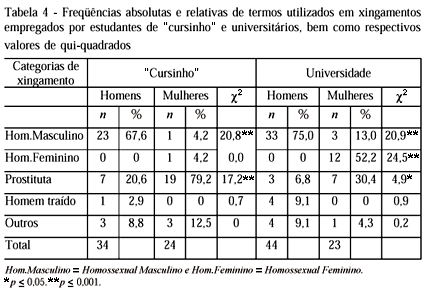Gender differences in restroom graffiti (N = 1349) were analyzed, focusing on aspects of the human sexuality. Graffiti were collected in restrooms from secondary schools ("cursinhos") and from a university, located in São Paulo, SP, Brazil. No significant gender differences were found in terms of frequency of sexual graffiti. However, the analysis of the sexual content of the inscriptions revealed significant differences. We used the Logistic Regression Model to verify the categories of sexual graffiti that differentiated men from women. At the secondary schools, the distinguishing categories were "anality" (B: 1,7560, df = 1, p < .01) and "insult" (B: .8843, df = 1, p < .01), themes preferred by men. At the university, the distinguishing categories were "insult" (B: .4445, df = 1, p < .05) and "sexual compliment" (B: -.7654, df = 1, p < .05): men produced a larger number of insults while women made more compliments. "Insult", therefore, was a category that differentiated genders in both locations: men were more aggressive than women when producing sexual graffiti. This result indicates that there may be some kind of connection between aggressiveness and sexuality.
Restroom graffiti; Gender differences; Sexuality; Aggressiveness




